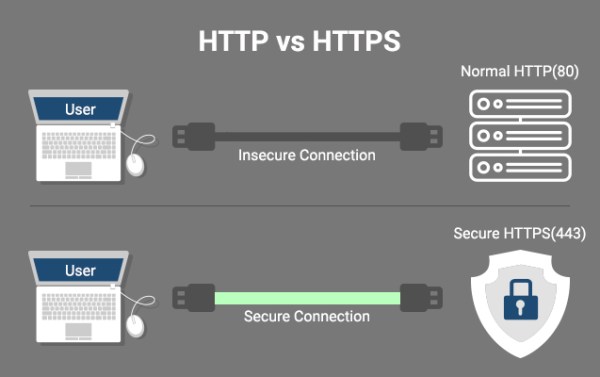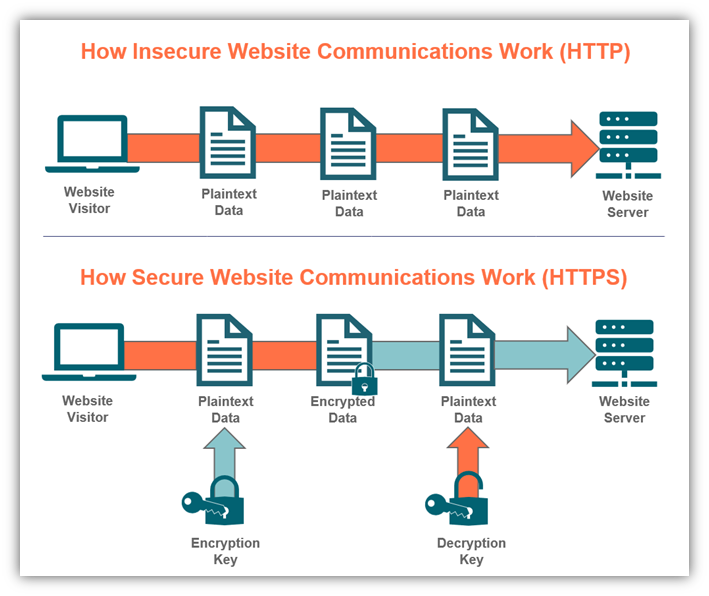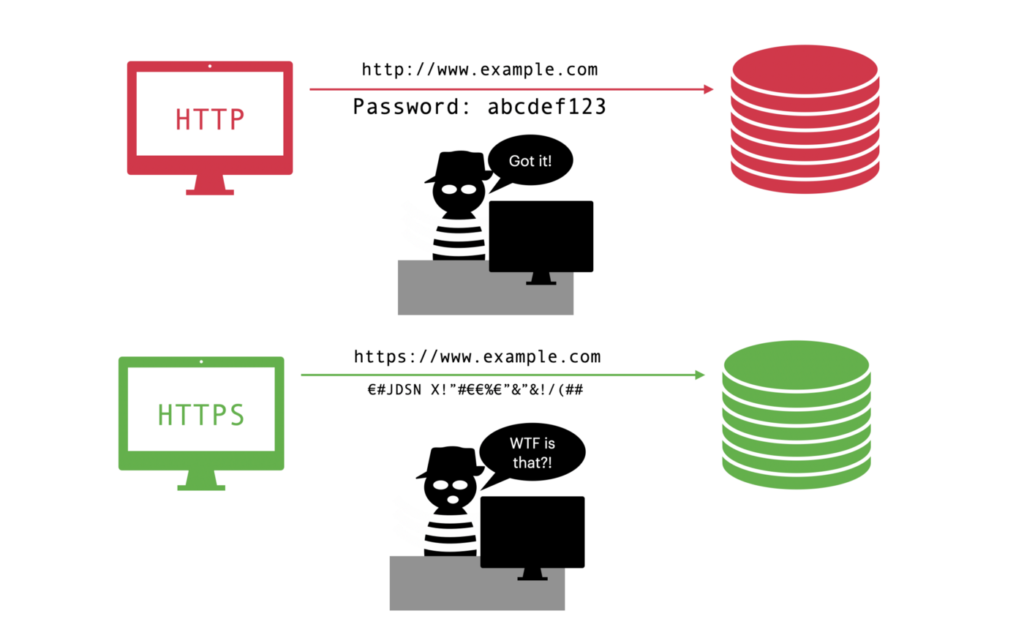HTTP vs. HTTPS: What are the differences?
HTTPS is HTTP with encryption. The only difference between the two protocols is that HTTPS uses TLS (SSL) to encrypt normal HTTP requests and responses. As a result, HTTPS is far more secure than HTTP. A website that uses HTTP has http:// in its URL, while a website that uses HTTPS has https://.

What is HTTP?
The whole backbone of the internet is HTTP or Hypertext Transfer Protocol. It’s the protocol that allows web pages to be processed, rendered, and sent from the server to the client browser.
HTTP is the primary technique for transferring data from web pages across a network. Web pages are stored on servers and delivered to client computers when the user requests them.
Because it delivers on-demand connections to browsers that initiate them, it is considered a stateless system.
Even though HTTP is the protocol used to display the majority of the internet, Google in 2014, advised sites to switch to HTTPS. In fact, Google said that as an incentive for moving over, it would give HTTPS sites a slight ranking boost, thus discouraging sites that did not migrate over by offering an advantage to competitors who did.
Until that time, HTTPS was only employed by e-commerce sites. So, why did Google make this move? Why was HTTPS more preferable than HTTP? To answer that, let us begin by exploring HTTPS.
What is HTTPS?
HTTPS (HyperText Transfer Protocol Secure) is an encrypted variant of HTTP, the most commonly used protocol for sending data over the Internet. Any website that has a lock icon in the address bar is using HTTPS.
HTTPS prevents your browser’s and server’s communication from being intercepted and tampered with by hackers. It does so by employing an SSL (Secure Sockets Layer) certificate, which aids in the establishment of a secure encrypted connection between the server and the browser. SSL prevents any potentially sensitive data from being stolen during transmission.
The great majority of today’s WWW traffic benefits from this degree of confidentiality, reliability, and authenticity.
Since HTTPS is sort of like the successor of HTTP, it is vital to know how it works.
How Does HTTPS Work?
The SSL certificate encrypts the data that users provide to the site, effectively converting it to a code. Even if a third-party attacker was to steal the data being sent between the sender and the receiver, the encryption would prevent them from comprehending it.
Furthermore, HTTPS adds an extra layer of security by using the TLS (Transport Layer Security) protocol. TLS helps ensure data integrity by preventing data from being changed or damaged during transmission. It also provides authentication by proving to your users that they are connecting with the correct website.

HTTP vs HTTPS Difference: Weighing The Perks
Understanding The Terms Better
Imagine passing a written message to your final recipient through a group of people. Now if the message is written in a language readable by everyone along the way, the recipients might benefit, misuse or take advantage of the information. Basically, how they use it will be beyond your control. This describes the working of HTTP.
Now imagine sending the same message in code language that only the final recipient will understand. Even the thought feels safer, right? This is how HTTPS encrypts the data and information that you share online.
While you might have come across the main difference as HTTP vs HTTPS security, however, the list goes way beyond to include HTTP vs HTTPS SEO and performance. To get a comprehensive outlook on both protocols, it is important to list the benefits. Let us begin by exploring the advantages of HTTP, followed by the ones in the HTTPS basket.
—————————————————————————————————
7 Advantages of HTTP
- Can Be Accessed Quickly
- It’s Flexible
- Advanced Addressing Mechanism
- Easy To Program
- Enables A Secure Transmission
- Amazing Search Capabilities
- Speedy Transmission
Here are seven perks of using HyperText Transfer Protocol:
1. Can Be Accessed Quickly
When a website is loaded for the first time, all of the HTTP pages are saved in the page cache, which is a type of internet cache. As a result, when the page is reloaded, the material loads rapidly.
2. It’s Flexible
HTTP has the ability to download extensions or plugins and show the required data whenever an application requires new capabilities. This ensures flexibility. The best examples of this would be Flash players and Acrobat Reader.
3. Advanced Addressing Mechanism
The HTTP protocol uses a sophisticated addressing system that gives IP addresses to known names so that they can be easily identified on the Internet. When compared to the conventional technique of an IP address followed by a sequence of digits, the public may simply engage with the internet using this method.
4. Easy To Program
HTTP is written in plain text, making it easier to understand and implement than protocols that rely on lookup codes. Data is presented in the form of lines of text instead of variables, thus making the entire process easy and streamlined.
5. Enables A Secure Transmission
Using HTTP 1.0, each file is downloaded separately and then closed. Because the independent connection only lasts during the transfer of a single element of a Web page, the danger of interception during transmission is reduced. Hypertext Transfer Protocol Secure (HTTPS) encrypts HTTP transactions to further increase security.
6. Amazing Search Capabilities
Despite being a basic communications protocol, HTTP allows you to search a database with a single request. This enables the protocol to do SQL searches and deliver results that are easily structured on an HTML page.
7. Speedy Transmission
A Web page is made up of a variety of components, such as text and pictures. Each component needs a varying quantity of storage and download resources. HTTP allows several connections to download different components at the same time, which speeds up the transmission. Each component is also given its own file type, allowing the receiving computer to process them more quickly and effectively.
5 Advantages of HTTPS
- Helps You Build Trust
- Helps Boost Website Rankings ( SEO)
- Provides Impeccable Security
- Helps Preserve Referrer Data (SEO)
- Qualifies You For AMP Pages
Here are the five perks of using HTTPS which helps with SEO and other things:
1. Helps You Build Trust
An HTTPS site encrypts all communication keeping visitors’ sensitive information protected. By keeping passwords, credit card information, browsing history, etc. safe – HTTPS helps you build a sense of trust in visitors. It will help you establish a healthy image and authenticity if you assure people that their information is protected while they browse your website. The same goes for the downloads, subscriptions, and purchases they make on your site. Obtaining leads and closing sales are also aided by this.
2. Helps Boost Website Rankings ( SEO)
As mentioned earlier, Google itself has encouraged HTTPS over HTTP by incentivizing the change through a minor hike in rankings. HTTPS can significantly help in enhancing your website’s rankings over time as users will be more inclined to browse through secure sites.
3. Provides Impeccable Security
This is an obvious one. HTTPS was introduced to make websites more secure and safe for users. In the case of HTTPS, the SSL/TLS certificate protects data while it is being transmitted between your website and the client.
Furthermore, if you implement a certificate to authenticate your identity, it will provide assurance of your site’s legitimacy, allowing consumers to believe that their data is safe. This distinguishes your website from those of phishing sites. This factor also helps in SEO as users will want to stick longer on a site that seems safe and authentic.
4. Helps Preserve Referrer Data (SEO)
Using an HTTPS site improves the effectiveness of Google Analytics. This is because HTTPS sites keep the security details of the website that referred you, but HTTP sites do not. Referral sources will display as “direct traffic” on HTTP sites. This alone offers HTTPS a significant SEO benefit.
5. Qualifies You For AMP Pages
Google introduced AMP (Accelerated Mobile Pages) as a means to load information onto mobile devices considerably more quickly. To provide a better mobile experience for smartphone and tablet users, AMP content is prominently displayed in Google’s SERPs.

HTTP vs HTTPS Difference: What Are The Downsides?
As fruitful as both systems are, HTTP and HTTPS have their disadvantages. Let us delve into them individually in the section below.
3 Disadvantages Of Implementing Hypertext Transfer Protocol
1. Lack Of Security
The most significant disadvantage of an HTTP website is that it does not provide secure communication as the data is not encrypted and is transmitted in plaintext format. Your data can be hacked, stolen, or altered by intruders when utilizing an HTTP site.
2. Lack Of Privacy
There is one big drawback to using an HTTP connection: data sent via an HTTP connection is not encrypted, putting you in danger of third-party hackers obtaining your data. If you are on an HTTP page, any credit card details or sensitive information should not be provided since any information transferred over this network via HTTP is not private.
3. Does Not Support IoT Devices
HTTP consumes more system resources, resulting in higher power usage. As a result, HTTP is not compatible with IoT devices nowadays since they incorporate wireless sensor networks.
—————————————————————————————————
3 Disadvantages Of Implementing HyperText Transfer Protocol Secure
1. Can Prove Uneconomical
You’ll need to get an SSL certificate after you switch to HTTPS. Despite the fact that many SSL certificates are provided by the website hosting provider, they must be updated annually for a charge – which can be a bit pricey.
Although there are ways to obtain a free SSL certificate, you might want to check the paid options and ensure security.
2. May Render Inaccessible
Some firewalls and proxy systems prevent HTTPS sites from being accessed. This can be both deliberate and unintentional. In the instance of a non-intentional breach, the administrators may have neglected to enable HTTPS access. This can sometimes be done on purpose as a security precaution.
3. Causes Problems In Catching
In HTTPS, some items will have caching issues. Those who were previously cached by the public will not be cached again, hence ISPs will be unable to cache encrypted material. These kinds of issues are more probable on sites that have a large number of visitors. However, these difficulties are mitigated as a result of increased bandwidth.
